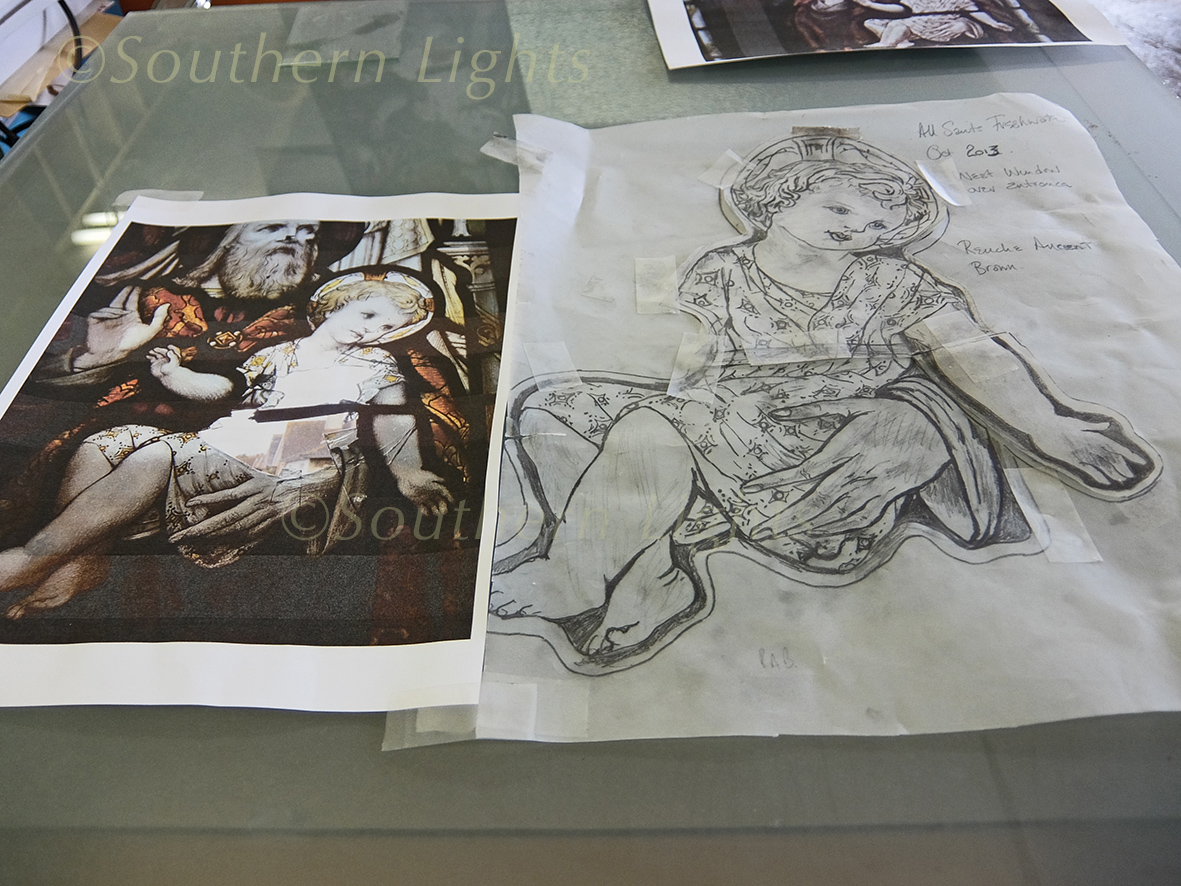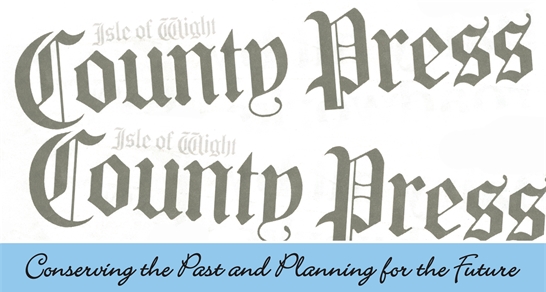Light streaming through a window can change mood especially if it is filtered through coloured glass.
Although referred to as a stained glass window it could be painted or manufactured in different ways and
held in lead cames to be a leaded light.
On the Isle of Wight there are over 70 churches, of different denominations. covering architectural
periods since the Saxon times. Many have alterations and additions or been rebuilt incorporating the
fashions in stained glass.
There is a timelessness about these windows but closer inspection reveals a history of scientific discovery
and technological development. Traditionally a stained glass window is one where ornate pictures and
images are painted onto glass, fired in a kiln and then fixed in place by cames of lead. It was too
expensive for the domestic market. The leaded light with formatted pieces of coloured glass was cheaper
and used much more in commercial and domestic architecture. It is characterised by a formality of
execution. It was used extensively in the Victorian era and is often an accompaniment to a stained glass
window.
The richness of the colours depends upon the metallic oxides added to the molten glass in the crucible.
The applied paint for the image is then fired to fix it. In leaded lights there is no need to paint and fire.
Poor quality firing shows up by a reduction in the clarity of the decoration.
Isabella de Fortibus is credited with introducing stained glass to the Isle of Wight.
To see the difference between stained glass windows and the leaded lights visit St. Catherine's in Ventnor.
To appreciate design quality compare those at St. Lawrence with those in Gatcome where the Pre-
Raphalite group provided the art work and then also see the design of G. F. Watts in Freshwater. To
admire the skill of the glaziers and their artistic craftsmanship see the restoration work at Brooke and
Mottistone. To look for the unusual find the bi-plane in St. Michael the Archangel at Shalfleet.
Modern treatments of window glass set in Saxon and Norman environments include those at Wootton and
Binstead. Most churches will give notes on their history and of special adornment including the windows.
Most ecclesiastical windows tell a story but on the Island the number of individual saints and angels is
considerable. Often a window has been dedicated with inscriptions to tell of useful lives lived or to loved
ones as at St. Blasius to “our little Kate”. Sometimes the dedication comes much later as at Brooke where
the 14centrury window is now the World War1 memorial. Quotations, incorporated, can be unclear as to
the reason behind them but they add to the illustration.
It is easy to look without seeing. Quiet contemplation upon a stained glass window or a leaded light gives
more than a pleasant image to focus on as the daylight changes. The Isle of Wight provides many
opportunities to be enriched by the experience and appreciate the heritage.
Stained-glass windows tell a story across the Island
By Helena Hewston
Light streaming through a window can change mood especially if it is filtered through coloured glass. Although referred to as a stained glass window it could be painted or manufactured in different ways and held in lead cames to be a leaded light.
On the Isle of Wight there are over 70 churches, of different denominations. covering architectural periods since the Saxon times. Many have alterations and additions or been rebuilt incorporating the fashions in stained glass.
There is a timelessness about these windows but closer inspection reveals a history of scientific discovery and technological development. Traditionally a stained glass window is one where ornate pictures and images are painted onto glass, fired in a kiln and then fixed in place by cames of lead. It was too expensive for the domestic market. The leaded light with formatted pieces of coloured glass was cheaper and used much more in commercial and domestic architecture. It is characterised by a formality of execution. It was used extensively in the Victorian era and is often an accompaniment to a stained glass window.
The richness of the colours depends upon the metallic oxides added to the molten glass in the crucible. The applied paint for the image is then fired to fix it. In leaded lights there is no need to paint and fire. Poor quality firing shows up by a reduction in the clarity of the decoration. Isabella de Fortibus is credited with introducing stained glass to the Isle of Wight.
To see the difference between stained glass windows and the leaded lights visit St. Catherine's in Ventnor. To appreciate design quality compare those at St. Lawrence with those in Gatcome where the Pre-Raphalite group provided the art work and then also see the design of G. F. Watts in Freshwater. To admire the skill of the glaziers and their artistic craftsmanship see the restoration work at Brooke and Mottistone. To look for the unusual find the bi-plane in St. Michael the Archangel at Shalfleet.

Drawings for repairs at All Saints Freshwater - Southern Lights
Modern treatments of window glass set in Saxon and Norman environments include those at Wootton and Binstead. Most churches will give notes on their history and of special adornment including the windows.
Most ecclesiastical windows tell a story but on the Island the number of individual saints and angels is considerable. Often a window has been dedicated with inscriptions to tell of useful lives lived or to loved ones as at St. Blasius to “our little Kate”. Sometimes the dedication comes much later as at Brooke where the 14centrury window is now the World War1 memorial. Quotations, incorporated, can be unclear as to the reason behind them but they add to the illustration.
It is easy to look without seeing. Quiet contemplation upon a stained glass window or a leaded light gives more than a pleasant image to focus on as the daylight changes. The Isle of Wight provides many opportunities to be enriched by the experience and appreciate the heritage.
Photograph and technical detail supplied by Southern Lights.
503 words
Although referred to as a stained glass window it could be painted or manufactured in different ways and
held in lead cames to be a leaded light.
On the Isle of Wight there are over 70 churches, of different denominations. covering architectural
periods since the Saxon times. Many have alterations and additions or been rebuilt incorporating the
fashions in stained glass.
There is a timelessness about these windows but closer inspection reveals a history of scientific discovery
and technological development. Traditionally a stained glass window is one where ornate pictures and
images are painted onto glass, fired in a kiln and then fixed in place by cames of lead. It was too
expensive for the domestic market. The leaded light with formatted pieces of coloured glass was cheaper
and used much more in commercial and domestic architecture. It is characterised by a formality of
execution. It was used extensively in the Victorian era and is often an accompaniment to a stained glass
window.
The richness of the colours depends upon the metallic oxides added to the molten glass in the crucible.
The applied paint for the image is then fired to fix it. In leaded lights there is no need to paint and fire.
Poor quality firing shows up by a reduction in the clarity of the decoration.
Isabella de Fortibus is credited with introducing stained glass to the Isle of Wight.
To see the difference between stained glass windows and the leaded lights visit St. Catherine's in Ventnor.
To appreciate design quality compare those at St. Lawrence with those in Gatcome where the Pre-
Raphalite group provided the art work and then also see the design of G. F. Watts in Freshwater. To
admire the skill of the glaziers and their artistic craftsmanship see the restoration work at Brooke and
Mottistone. To look for the unusual find the bi-plane in St. Michael the Archangel at Shalfleet.
Modern treatments of window glass set in Saxon and Norman environments include those at Wootton and
Binstead. Most churches will give notes on their history and of special adornment including the windows.
Most ecclesiastical windows tell a story but on the Island the number of individual saints and angels is
considerable. Often a window has been dedicated with inscriptions to tell of useful lives lived or to loved
ones as at St. Blasius to “our little Kate”. Sometimes the dedication comes much later as at Brooke where
the 14centrury window is now the World War1 memorial. Quotations, incorporated, can be unclear as to
the reason behind them but they add to the illustration.
It is easy to look without seeing. Quiet contemplation upon a stained glass window or a leaded light gives
more than a pleasant image to focus on as the daylight changes. The Isle of Wight provides many
opportunities to be enriched by the experience and appreciate the heritage.
Photographs and technical detail supplied by Southern Lights.


